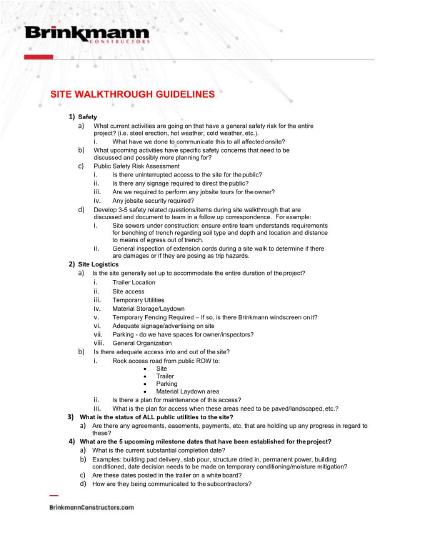|
What is Included in the Site Walkthrough Guidelines?
- Safety
- Site Logistics
- Status of Public Utilities
- Milestones
- Weather
- Risks Outside of Contractual Control
- Getting Ahead
- Sequence/Flow
- QA/QC
- Team Discussions/Hot List
|

|
| SITE WALKTHROUGH GUIDELINES 101 |
|
|
Why They're Important
- The intent of a site walkthrough is not only to check progress of the job but to be thinking about HOW things are done, WHAT is being done, and WHY things are being done in the way they are.
- i.e. assemblies, flow, means and methods
- Escape the "tunnel vision"
- The process can allow you and your team to be proactive instead of reactive
- Great opportunity for you to ask questions to subs and learn about their processes
- Alignment across the entire organization on expectations no matter the size of the project, tenure of the team, geographical location of the project, dollar volume, market sector or anything else that differentiates your project from another, these guidelines will always hold true.
|
Training Resources
- Best training is experience
- Walk with your super, general super, PM, etc. and ask questions!
- What are you seeing
- Can you explain their means and methods?
- What is this and what's its function
- Review the Site Walkthrough Guidelines
|
| SITE WALKTHROUGH GUIDELINES BY SECTION |
|
|
Safety
- Identify any activities with potential safety issues
- If safety concerns are seen:
- Address immediately if easy to fix
- Examples: Remove nail from board, PPE, buckle up
- Create an observation if something takes more time
- Examples: Adding guard rails, rebar needs bar caps, unsafe scaffolding
- Create follow-up for future safety concerns or best practices
- Never leave safety hazard without notifying the contractor responsible or your superintendent
- Site Walkthrough Guidelines are NOT the time to write-up weekly safety inspections
- This should be done via a dedicated safety inspection walk
|
Site Logistics
- Set the site up for success
- Is the job trailer placed where they will be out of the way for the duration of the project?
- Is material being stored in a location where it doesn't need to be moved multiple times?
- Parking on site?
- Site access?
- Project flow
|
|
Utilities and Easements
- Have the utility applications been completed?
- ETA for service installation?
- ETA for equipment installation?
- Easements recorded and executed?
- Any costs and who is responsible?
- Utilities
- Understanding contracts and what contractors are responsible for
- Know what is required for the Electrical and Gas companies to perform their connections.
- Easements
- Review easements with your PM/Super. Different easements have different requirements.
- Example: In Boulder, if you have a public access easement on your site for a future path that Brinkmann has yet to build, you cannot place a trailer in the easement, even if nothing is built and there is no access.
|
Milestones
- Know what contractually obligated milestones your project has
- Set up internal milestones with your team
- Example Milestones
- Start/Stop framing
- Start/Stop concrete
- Start/Stop roofing
- Establish permanent power
- Communicate these milestones with the subcontractors
|
|
Weather
- Identify the activities impacted by weather
- Which activities are critical path?
- Is the site prepared for upcoming weather?
- Site slicked off
- Loose material picked up/stored properly?
- How are weather delays being tracked and communicated to the owner?
- Can we minimize weather impacts?
|
Unforeseen Conditions
- Permits - Delays by AHJ
- International events - how does it affect procurement
- Unstable market/inflation
- Owner directs subs (FFE)
- Examples: fuel cells, structures, ground water, fossils
|
|
Getting Ahead and Flow
- Is there open space for another sub to get started
- Are predecessor activities far enough ahead that we can request extra manpower?
- Working weekends to make up weather days?
- Do the subs on site have enough space and work ahead of them to keep going?
- Are all RFI's and submittals answered to keep subs moving?
- Procurement: Is there room on site for current and future material needs?
|
Quality Control
- If something looks wrong, stop to investigate
- If you are unsure what a sub is doing, ask! Have them explain their means and methods.
- Request to see their drawings and ensure their drawings are the latest and greatest.
- If something still doesn't look right, ask your superintendent to investigate and have them explain what they are seeing.
- Mock-Ups
- Not all jobs have them, but they will be used as the final check for compliance
- When major scopes of work are getting ready to be completed, perform a QC walk
- Outlets, plumbing, and framing prior to drywall
- After drywall, make sure all outlets and switches are exposed
- Rebar inspections prior to pours
- Plumbing prior to backfill
|
|
Critical Items
- Determine a hot list and post it in the trailer
- Submittals
- Procurement
- Permits
- Utilities
|
|
| OBSERVATIONS |
|
|
Types of Observations Most Commonly Used
- Storm Water
- Corrective Action
- Pre-Punch
- COVID-19
- Safety Hazard/Notice/Violation
|
Why Are They Important
- Observations are made during site walks via Procore
- Observations help track all deficiencies/concerns
- Puts responsibility on sub and takes away opportunities for excuses when it doesn't get done.
|



